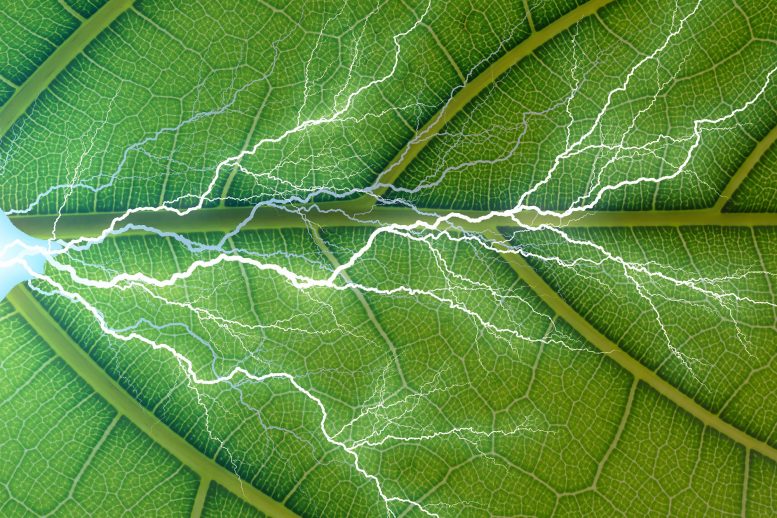
Replicating the capture and utilization of carbon dioxide (CO2) from the atmosphere poses a significant challenge for scientists. The Argonne National Laboratory and SLAC National Accelerator Laboratory are working towards capturing carbon dioxide directly from the air and transforming it into useful products through artificial photosynthesis.
Argonne and SLAC will develop artificial photosynthesis methods to enable direct air capture of CO2 while expanding sources of energy through the conversion of CO2 to fuels and other useful chemicals.
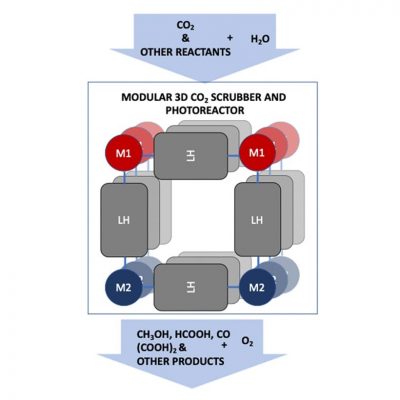
In this project, researchers will explore a molecular photoreactor that captures CO2 and converts it to fuels and useful chemicals. (Image by Argonne National Laboratory.
Leaves make it look easy, but capturing and using carbon dioxide (CO2) from the air is a challenging process for scientists to mimic.
To artificially capture CO2, chemists have developed ways to “scrub” it from the air using chemicals that react very favorably with it. But even after it is captured, it’s often difficult to release and use for artificial photosynthesis.
The U.S. Department of Energy’s (DOE) Argonne National Laboratory and SLAC National Accelerator Laboratory will receive $4.5 million over three years from the DOE for research aimed at capturing carbon dioxide directly from air and converting it into useful products by artificial photosynthesis.
“We were thrilled to get the opportunity to do new science and to work on this challenge. It would be enormously satisfying to open up a new, environmentally sound means of generating energy. A major advancement in this area would be the highlight of my career.” — Ksenija Glusac, Argonne chemist, Solar Energy Conversion group, Chemical Sciences and Engineering division
CO2 capture involves trapping the gas, transporting it to a storage location, and isolating it. Together, Argonne and SLAC will focus on developing photochemical methods that enable CO2 capture directly from air and that combine this capture with photochemical conversion to fuels and value-added chemicals.
Their goal is to improve the environment and expand sources of energy through the conversion of CO2 to fuels and other value-added chemicals such as methanol and acrylic acid derivatives — both of which are used by the chemical industry to make polymers, including resins, plastics, and glues. Methanol also can be used as a fuel to generate electricity.
Ksenija Glusac, a chemist with the Solar Energy Conversion group in the Chemical Sciences and Engineering division at Argonne, will lead Argonne’s efforts as the principal investigator for the group.
Glusac has worked in the field of artificial photosynthesis since 2000, but combining CO2 capture with photosynthesis is a new direction for her and her team.
“We were thrilled to get the opportunity to do new science and to work on this challenge,” said Glusac, who is also an associate professor of chemistry at the University of Illinois at Chicago. “It would be enormously satisfying to open up a new, environmentally sound means of generating energy.”
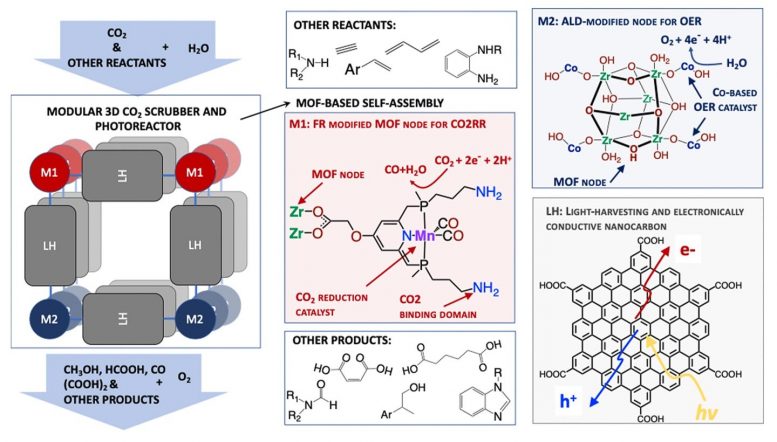
This photoreactor will be built up of molecular Lego pieces, each designed to perform a certain function: chromophores that absorb and harvest the sunlight, molecules that capture CO2 from the atmosphere, and catalysts that convert CO2 to value-added chemicals. Credit: Argonne National Laboratory
Glusac’s team has already contributed significantly to the field of artificial photosynthesis. After years of studying the interaction between matter and electromagnetic radiation, they expanded scientists’ understanding of what happens in materials in regard to the absorption of light — and the conversion of that light to energy.
“The current project builds on our extensive experience and opens up the opportunity of combining CO2 capture with photosynthesis,” Glusac said.
Glusac and her team plan to use Argonne’s Advanced Photon Source (APS), SLAC’s Stanford Synchrotron Radiation Lightsource (SSRL), and SLAC’s Linac Coherent Light Source (LCLS) — all are DOE Office of Science User Facilities — to collect X-ray absorption and scattering measurements to better understand the CO2 capture and photo-conversion mechanisms.
The APS’s high-energy storage ring generates ultrabright, hard X-ray beams for research in almost all scientific disciplines while SSRL provides electromagnetic radiation in the X-ray, ultraviolet, visible, and infrared realms produced by electrons circulating in a storage ring. LCLS takes X-ray snapshots of atoms and molecules at work, providing atomic resolution detail on ultrafast timescales to reveal fundamental processes in materials, technology, and living things.
Glusac and her team will take these measurements from samples of supramolecular structures called MOFs (metal-organic frameworks) that can absorb and harvest solar light and nodes that host two types of catalysts: reduction catalysts that can capture CO2 from the air and reduce it to value-added chemicals and oxidation catalysts that can convert water to oxygen.
“Our approach aims to combine CO2 capture and artificial photosynthesis into a single process, called photoreactive capture,” Glusac said. “We will explore molecular photoreactors that can both scrub CO2 and use sunlight to convert it into useful chemicals. We have great hope for this endeavor.”
Argonne’s Laboratory Computing Resource Center will be used to perform the computational investigations of CO2 capture and conversion mechanisms.
In addition to Glusac, Argonne’s team includes Lin Chen, David Kaphan, Karen Mulfort, Alex Martinson, David Tiede and Peter Zapol. Amy Cordones-Hahn from SLAC rounds out the group.
Projects were selected by competitive peer review and supported by DOE’s Office of Science.

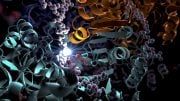
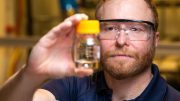


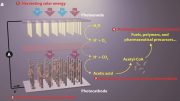



Hire a professional writer that knows to define acronyms, in this case, SLAC. Try to be respectful of your readers’ time. Your headline was clickbait and was amateurish, so I’ll respect my own time by removing this site from my news app.
Sadly, Chris, this seems to be what this website is all about. That’s why they MUST slip in some bollocks about Big Bang into every single astronomy article despite Big Bang being an unproven and findamentally weak hypothesis.
Unfortunately such tech, at best, is like using a heart lung machine to keep a corpse alive. pulling CO2 out of the air and turning it into fuel doesn’t accomplish anything useful aside from keeping the CO2 level of the atmosphere at constantly too high of a concentration. Now, if you want to do something useful, find a profitable way to quickly and easily convert atmospheric CO2 into marble, then we wouldn’t be pulling it out of the air and then burning it to put it right back in the air after a large expense of energy.
> find a profitable way to quickly and easily convert atmospheric CO2 into marble
I don’t know about marble, but trees are pretty profitable to grow and convert CO2 into wood. So long as the wood products are durable (houses, good furniture) they can stick around for centuries.
Biorock is a method to grow mineralized structures by precipitation in seawater. It needs a conductive wire frame and electricity. One of the minerals is calcium carbonate i.e. limestone. Marble is just limestone which has been metamorphosed by the Earth’s heat. Chemically its the same.
There are two positives: 1. removal of CO2 and not burning the product
2. removal of CO2 from atmos and converting into a non-fuel chemical which does not end up as a CO2 polluter. Possibilities: wood substitute, tires, plastic, cloth
Interesting Research.
However its is just a start.
The comments above are limited in nature as they refect the immediate valueof such research.
The vision of the importance of photosynthesis in humanity’s futture is grossly underestimated. Wonder what I mean by this. Well here goes. My vision of how important this research and such future research is based on Scientific facts and oerinciples.
We breathe in Oxygen and breathe out Carbon Di Oxide. The Trees , some of which live for generations absorb the carbon di oxide and convert it to Wood and ensure the level of Oxygen required for species is maintd at the optimal level.
My good friend Dwiht Lauer from the school of forrestary at UGA used to make corny jokes about tress and Leafs and I never thought how important photosynthesis would be in the future of Humanity. He used to say with a sly smuile on his face — “Make Like a Tree and Leaf” when his girl-friend used to come to visit him!
Well , the Leaf is able to convert the solar rays to stored energy vide Photosynthesis. Without Photosynthesis the food we get would be unavailable and Life as we know will cease to exist.
Now , coming to the vision part of the painting.
Humans as I said earlier breathe in Oxygen and breathe out Carbon Di Oxide.If instead of expelling Carbon Di Oxide , if Humans develop the ability to convert the Carbon Di xide into Energy vide a processes of Internal modified Photosynthesis we would have achieved a major breakthrough. as these stores of energy can supply the optimal level of energy required by the Mitochondrial cells for healthy functioning without actually having to consume food. The importance of this should not be underestimated as such a modified human characteristic may be essentail for long space voyages to the stars as sub light sppeds which may take a feyears and growing crops on the space ship may not be practical as a single crop failure midway can ensure that the g=gumans arrive dead at the destination. or is it practical to carry food from Earth ….
So long duration space voyages may only be possible if we can master and use the process of photosynthesis effecively. In addition long term data on space travel and exposure to Zero gravity environment may be dangerous and research shows that the mitochondral imabalance of long duration stay in Space is not good for Human Health.
I like the research but trees already do this pretty well.
Yes trees do it very well. Figuring out exactly how they do it and developing technology that can speed up the repair of our ozone layer would be highly beneficial and may save the planet and ourselves. This seems worth investigating and investing in. Of course we have to do this in conjunction with getting rid of our emissions using green tech. I hope we can pull this off.